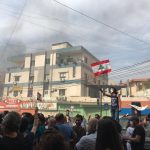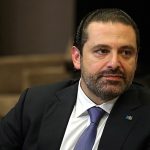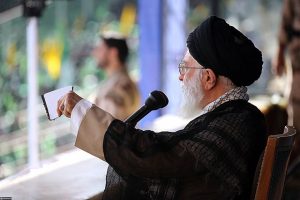by Joe Macaron
While the latest American sanctions, imposed on July 9, continue a trend of US pressure on Hezbollah, they symbolize an imperfect realignment of interests between the Trump Administration’s Iran approach and Lebanese leaders’ aim to alter their country’s political dynamics. Lebanon has been mostly shielded from US-Iranian tensions over the nuclear deal, but there are questions about whether this is about to change.
Sanctioning Hezbollah
The Trump Administration has been targeting, in a gradual way, the eight members of Hezbollah’s core leadership in the Shura Council, under the Treasury Department’s Office of Foreign Assets Control. In May 2017, the first target was Hashem Safieddine, who heads the executive council known as Hezbollah’s government. The following year, in May 2018, five members were targeted: Secretary General Hassan Nasrallah, his deputy Naim Qassem, and his assistant for political affairs Hussein Khalil; Ibrahim Amin al-Sayyid, who leads the political council; and Mohammad Yazbek, who heads the judicial council that resolves partisan disputes and is a “spiritual reference” (marjaa) tasked by Iran’s Supreme Leader Ali Khamenei. On July 9, 2019 the seventh target was sanctioned: Mohammad Raad, who chairs Hezbollah’s parliamentary bloc. The only non-sanctioned member of the Shura Council is Jawad Noureldin, who has no specific portfolio and is tasked as needed to liaise between the group’s political and military branches.
There is, however, political symbolism in the most recent sanctions that included, in addition to Mohammad Raad, his fellow parliamentarian Amin Sherri and the head of Hezbollah’s liaison and coordination unit, Wafiq Safa (the Treasury Department’s announcement wrongly identified Safa’s position as head of Hezbollah’s security apparatus). The symbolism of sanctioning Raad is that he has been chairing Hezbollah’s parliamentary bloc since 1992 and it is the first time the United States has sanctioned a seated Lebanese deputy who, incidentally, won the largest number of votes (43,797) in the May 2018 elections. Raad belongs to the first generation of Hezbollah founders who came from the Islamist Daawa Party. The Trump Administration is targeting Hezbollah’s political representation in the parliament, which is a step up in the pressure campaign. The US Treasury Department noted that these sanctions highlight how Hezbollah “uses its political power to corrupt and exploit Lebanon’s financial and security elements, taking advantage of the country’s democratic system and values.”
All the roads that link Hezbollah’s military wing to Lebanon’s security institutions go through Wafiq Safa, who assumed his position in 2005 when Hezbollah, as an organization, was shifting focus and expanding influence over the Lebanese political system, after the Syrian regime withdrew its forces from Lebanon. Previously, Safa was the main negotiator for Hezbollah’s prisoner exchange with Israel, via European mediators, and one of the group’s founders with close ties to Nasrallah—hence his status in Hezbollah’s political wing should not be underestimated. Safa is omnipresent in Lebanon’s social activities and makes himself accessible to the media, and he is one of the less rigid Hezbollah figures. While he has been a key Hezbollah interlocutor and/or enforcer with Lebanese leaders for a decade, Safa saw his political portfolio downsized last year following the 2018 legislative elections; he is now strictly focused on serving as a liaison between Hezbollah’s security apparatus and Lebanon’s official security institutions. Yet, Safa kept one crucial political portfolio: Hezbollah’s relationship with Foreign Affairs Minister Gebran Bassil, President Michel Aoun’s son-in-law and the current leader of the Free Patriotic Movement. Therefore, when sanctioning Safa, the United States is also targeting the Lebanese state-Hezbollah link and potentially Hezbollah’s relationship with Aoun and Bassil.
Amin Sherri is a businessman in Hezbollah’s parliamentary bloc and has been playing a quiet role as a link between Hezbollah and Lebanese banks, which explains why the United States Treasury says he threatened these financial institutions. By sanctioning Sherri, the Trump Administration is either sending a message of support for Lebanese banks that closely coordinate with Washington and/or is targeting the coordination between Hezbollah and Lebanese banks to evade sanctions.
Sanctions at a Difficult Political Time
While these latest sanctions come in the context of US-Iranian tensions, they should also be seen through the lens of the recent political turmoil in Lebanon. The Druze leader and head of the Socialist Party, Walid Joumblatt, has been spearheading the Lebanese feudal leaders’ efforts to change the dynamics of the 2016 presidential deal that brought both President Michel Aoun and Prime Minister Saad Hariri to power under Hezbollah’s auspices. More specifically, Joumblatt and Lebanese Forces Leader Samir Geagea, among others, are alarmed by Bassil’s growing influence in the government and over Hariri. Most recently, these political tensions took a dangerous turn. Two bodyguards of minister Saleh al-Gharib, who is affiliated with Druze leader Talal Arslan and subsequently with President Aoun, were killed in a clash with Joumblatt’s loyalists. The purpose was to thwart the emboldened Bassil’s visit to Joumblatt’s stronghold in Mount Lebanon. The US sanctions came on the heels of this most acute crisis facing the Lebanese government since its formation last January.
The Trump Administration’s recent sanctions against Hezbollah and the way they were subtly explained in the announcements look as if Washington is trying to weigh in on Lebanese politics by sending messages to Hariri to distance himself more from Aoun-Hezbollah as well as to the Europeans to sanction both Hezbollah’s political and military wings. While the coordination has halted between the Hariri-led al-Mustaqbal (Future) Movement and Hezbollah, the two sides are cooperating within the government. The Shia group is facilitating Hariri’s job more than his traditional allies, Joumblatt and Geagea, who feel excluded from the Hariri-Bassil alliance that has the largest stake in the government’s decisions and appointments.
The US goals behind these sanctions are not necessarily synchronized with the goals of Lebanese leaders challenging the 2016 presidential deal. While the Trump Administration is seeking to at least widen the distance between the Hariri government and Hezbollah, these Lebanese leaders are rather focused on driving a wedge between Hariri and Bassil.
These sanctions remain symbolic, absent a clear and coherent US policy in Lebanon and the Levant. If Hariri confronts the Free Patriotic Movement or Hezbollah, his government will either enter a stalemate or potentially get sacked, triggering a long and unpredictable political crisis since no Sunni leader would be able to take up the mantle from Hariri. The Lebanese prime minister has no choice but to weather yet more US sanctions on Lebanon. For his part, Safa has been meeting with Interior Minister Raya El Hassan, who is affiliated with Hariri, to coordinate removing the concrete barriers from Hezbollah’s stronghold in Dahieh, the suburb south of Beirut. This is an example of how Hariri’s government would be unable to function properly without having some line of direct or indirect communication with Hezbollah. Apparently blindsided by these US sanctions, the tendency of the Hariri government is to let President Aoun take the lead on this issue, rather than Hezbollah. Prime Minister Hariri himself seems inclined to remain publicly neutral on the sanctions, neither endorsing them nor defending Hezbollah. However, Hariri is simultaneously looking to reinstate a Saudi role in Lebanon to improve his relatively weak political influence in Lebanese politics.
The 2016 presidential deal was a US-Iran tacit arrangement and those leaders in Beirut who did not benefit from it now see an opportunity in the renewed tensions between Washington and Tehran. It will not be the first nor the last time Lebanese leaders look for external support to shore up their standing at home. However, and in an analogy to Iran’s nuclear agreement, altering this flawed presidential deal without providing an alternative might expose Lebanon’s fragile stability.
One of the casualties of the latest Trump Administration move might be the US mediation of the border dispute between Lebanon and Israel. Former Acting Secretary of State David Satterfield, tasked to lead this mediation, made no breakthrough during his last trip to Beirut. While the Trump Administration seems committed to this mediation, it might be harder for the talks with Israel to proceed in this environment, which shows once again the conflicting agendas of the White House in the Middle East.
The Trump Administration grew increasingly confident in recent months in its ability to influence Lebanese politics, most notably after Washington managed to pressure Beirut to express willingness to engage in border talks with Israel and given that Hezbollah is experiencing a financial hardship and is asking for donations from its supporters. However, pushing the envelope might backfire against US interests. Lebanese leaders, who are watching Trump as he announces withdrawal from Syria and backtracks on a strike on Iran, still remember vividly how the George W. Bush Administration did not provide any support for the March 14 Alliance when it attempted to rein in Hezbollah in 2008. Sanctions are just one piece of the puzzle; the United States first needs a well-considered and coherent Lebanon policy.
Joe Macaron is a Resident Fellow at Arab Center Washington DC. To learn more about Joe and read his previous publications click here. Republished, with permission, from the Arab Center.




